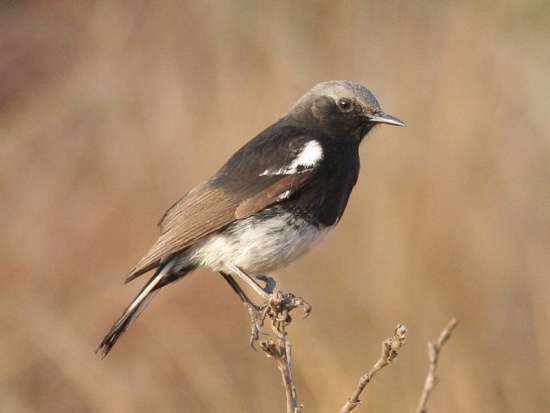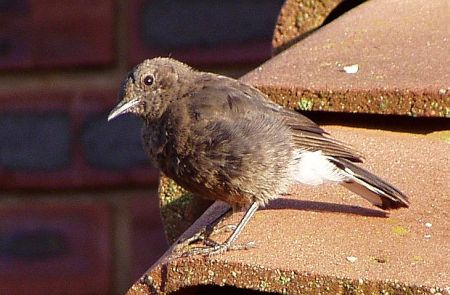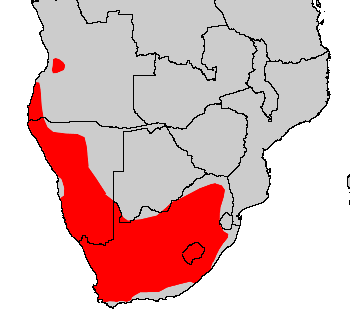m |
(Update genus and GSearch + taxon, refs) |
||
| Line 1: | Line 1: | ||
| − | |||
[[Image:Mountain_Wheatear.jpg|thumb|550px|right|Male Mountain Wheatear<br>Photo by GarethH<br/>Photo Taken: Suikerbosrand NR, South Africa]] | [[Image:Mountain_Wheatear.jpg|thumb|550px|right|Male Mountain Wheatear<br>Photo by GarethH<br/>Photo Taken: Suikerbosrand NR, South Africa]] | ||
| − | [[ | + | ;[[:Category:Myrmecocichla|Myrmecocichla]] monticola |
| + | ''Oenanthe monticola'' | ||
| + | |||
==Identification== | ==Identification== | ||
Length 18-20 cm, mass about 35 g. | Length 18-20 cm, mass about 35 g. | ||
| Line 9: | Line 10: | ||
'''Adult female:''' Dark brown, with a white rump and outer tail. | '''Adult female:''' Dark brown, with a white rump and outer tail. | ||
| + | [[Image:2006_0107_Female_Mountain_Wheatear.jpg|thumb|450px|right|Female Mountain Wheatear<br>Photo by Alan Manson<br>Qwantani Resort, Sterkfontein Dam, Free State, South Africa]] | ||
==Distribution== | ==Distribution== | ||
[[Image:Mountain_Wheatear.png|thumb|350px|right|Graphic by Nrg800]] | [[Image:Mountain_Wheatear.png|thumb|350px|right|Graphic by Nrg800]] | ||
| Line 17: | Line 19: | ||
Placed in genus ''[[:Category:Myrmelocichla|Myrmelocichla]]'' by Gill and Donsker. | Placed in genus ''[[:Category:Myrmelocichla|Myrmelocichla]]'' by Gill and Donsker. | ||
| − | + | ====Subspecies==== | |
| + | Four subspecies are recognized<sup>[[#References|[1]]]</sup>. | ||
| + | *''M. m. albipileata'' - Coastal [[Angola]] (Benguela escarpment) | ||
| + | *''M. m. nigricauda'' - Angola (highlands of Huambo and southern Cuanza Sul) | ||
| + | *''M. m. atmorii'' - Northern [[Namibia]] (south to Damaraland) | ||
| + | *''M. m. monticola'' - Southern Namibia, [[South Africa]] (east to Limpopo and western KwaZulu-Natal), [[Lesotho]], and western [[Swaziland]] | ||
| + | |||
==Habitat== | ==Habitat== | ||
Mountains and rocky areas. | Mountains and rocky areas. | ||
| Line 25: | Line 33: | ||
'''Breeding''': Nests on the ground amongst rocks; 2-4 white eggs are laid June to March. | '''Breeding''': Nests on the ground amongst rocks; 2-4 white eggs are laid June to March. | ||
==References== | ==References== | ||
| − | Hockey PAR, Dean WRJ & Ryan PG (eds) 2005. Robert's Birds of Southern Africa, 7th edition. John Voelcker Bird Book Fund, Cape Town, South Africa. ISBN 0620340533 | + | #{{Ref-Clements6thAug19}}#Hockey PAR, Dean WRJ & Ryan PG (eds) 2005. Robert's Birds of Southern Africa, 7th edition. John Voelcker Bird Book Fund, Cape Town, South Africa. ISBN 0620340533 |
==External Links== | ==External Links== | ||
| − | {{GSearch| | + | {{GSearch|Myrmecocichla+monticola}} |
[[Image:29749Mountain_Wheatear_safariranger_DaanViljoenGR_Namibia.jpg|thumb|350px|right|Male Mountain Wheatear - black-bellied morph<br>Photo by safariranger<br>Daan Viljoen Game Reserve, Namibia]] | [[Image:29749Mountain_Wheatear_safariranger_DaanViljoenGR_Namibia.jpg|thumb|350px|right|Male Mountain Wheatear - black-bellied morph<br>Photo by safariranger<br>Daan Viljoen Game Reserve, Namibia]] | ||
[[Image:23133mt_chat_MeganPerkins_DaanViljoen_Namibia.jpg|thumb|450px|left|Male Mountain Wheatear - black-crowned morph<br>Photo by Megan Perkins<br>Daan Viljoen Game Reserve, Namibia]] | [[Image:23133mt_chat_MeganPerkins_DaanViljoen_Namibia.jpg|thumb|450px|left|Male Mountain Wheatear - black-crowned morph<br>Photo by Megan Perkins<br>Daan Viljoen Game Reserve, Namibia]] | ||
| − | [[Category:Birds]] [[Category:Maps]] [[Category: | + | [[Category:Birds]] [[Category:Maps]] [[Category:Myrmecocichla]] |
Revision as of 01:43, 26 June 2021
- Myrmecocichla monticola
Oenanthe monticola
Identification
Length 18-20 cm, mass about 35 g.
Adult male: There are several colour morphs; body plumage may be pale grey or black, and the crown may be white, grey or black. The wings are very dark brown or black with a white shoulder patch which varies in size (sometimes all black). The tail pattern is distinctive, with a white rump and outer tail feathers. The legs and pointed bill are black.
Adult female: Dark brown, with a white rump and outer tail.
Distribution
Namibia, South Africa, Lesotho, western Swaziland extreme southern Botswana and western Angola.
Taxonomy
Formerly classed as a member of the Thrush family (Turdidae), but is now more generally considered to be an Old-World Flycatcher (Family Muscicapidae).
Placed in genus Myrmelocichla by Gill and Donsker.
Subspecies
Four subspecies are recognized[1].
- M. m. albipileata - Coastal Angola (Benguela escarpment)
- M. m. nigricauda - Angola (highlands of Huambo and southern Cuanza Sul)
- M. m. atmorii - Northern Namibia (south to Damaraland)
- M. m. monticola - Southern Namibia, South Africa (east to Limpopo and western KwaZulu-Natal), Lesotho, and western Swaziland
Habitat
Mountains and rocky areas.
Behaviour
Food: Mainly insects, but also other invertebrates, seeds and berries.
Breeding: Nests on the ground amongst rocks; 2-4 white eggs are laid June to March.
References
- Clements, J. F., T. S. Schulenberg, M. J. Iliff, S. M. Billerman, T. A. Fredericks, B. L. Sullivan, and C. L. Wood. 2019. The eBird/Clements Checklist of Birds of the World: v2019. Downloaded from http://www.birds.cornell.edu/clementschecklist/download/
- Hockey PAR, Dean WRJ & Ryan PG (eds) 2005. Robert's Birds of Southern Africa, 7th edition. John Voelcker Bird Book Fund, Cape Town, South Africa. ISBN 0620340533








